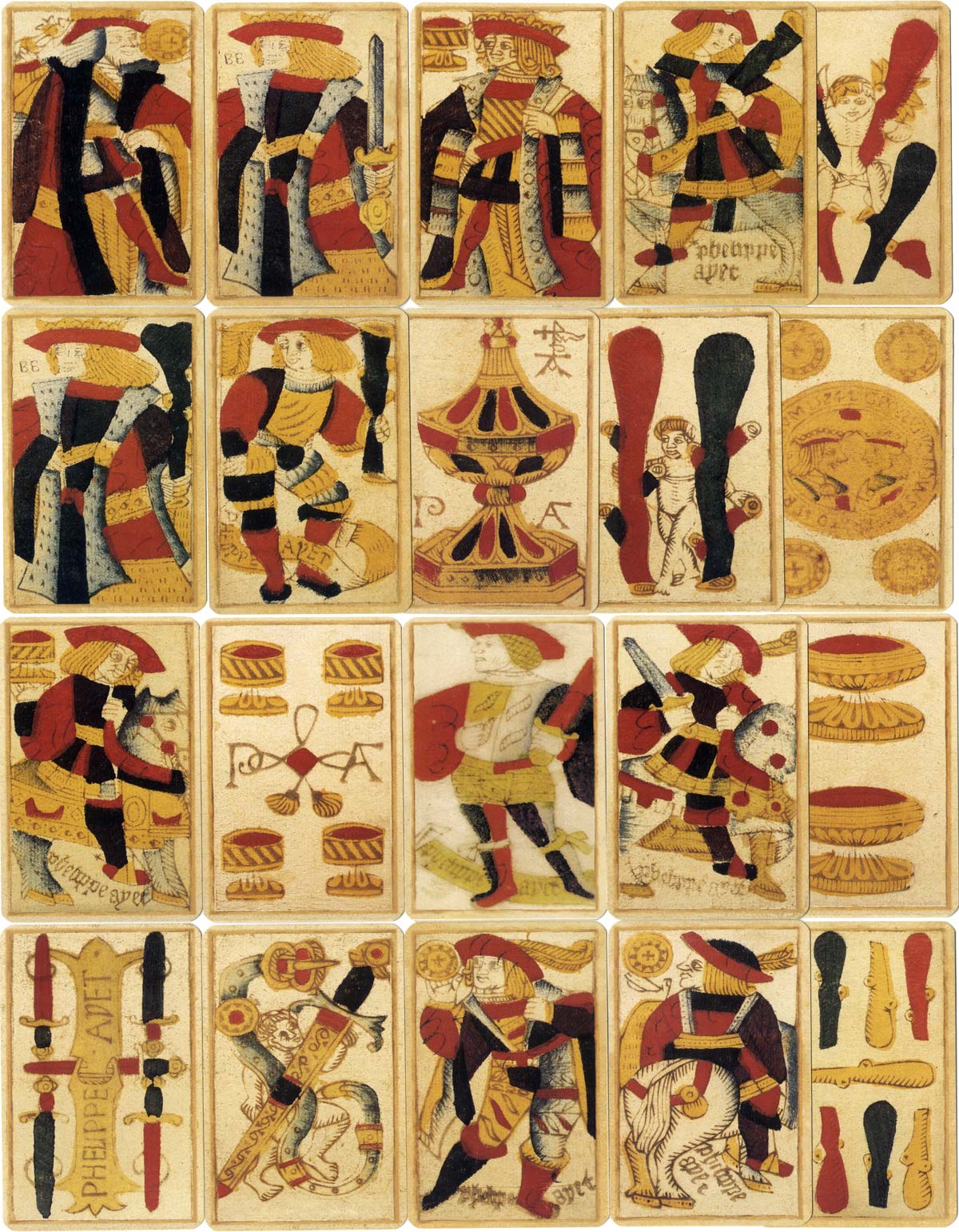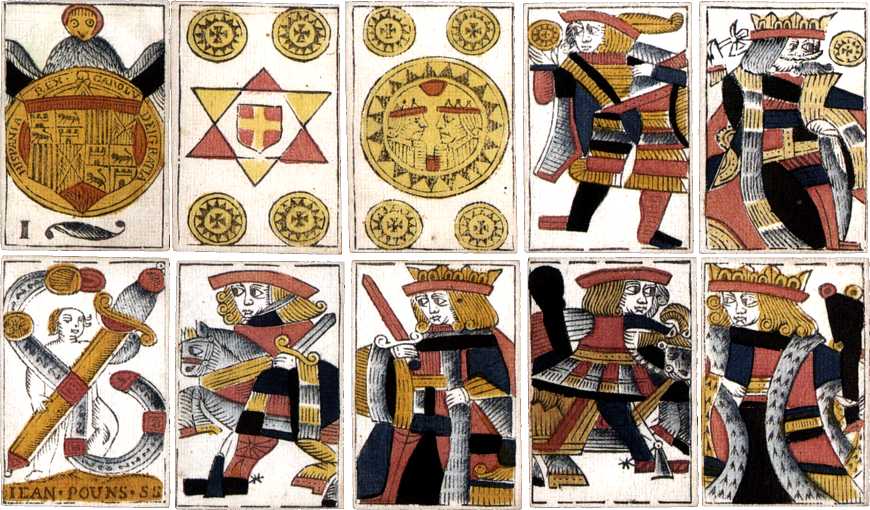Phelippe Ayet, c.1574
Archaic, late medieval Spanish-suited playing cards printed by Phelippe Ayet, c.1574.
Archaic, late medieval Spanish-suited designs
Cards from a Spanish-suited pack made by Phelippe Ayet, c. 1574 were found in the Torre de los Lujanes in Madrid during demolition, and are now in the collection of the Gabinete de Antiguedades Real Academia de la Historia, Madrid. 44 cards were found in total, derived from possibly three separate packs; approximate size: 11.5 x 8 cms. Opinion is divided over whether the cards were made in France, possibly Thiers, and imported into Spain, or else made in Catalonia by a French or Flemish card maker. The style is an archaic, late medieval type, which pre-dates the Spanish National pattern. The King of Coins wields a battle axe over his shoulder and can be found in later cards from Provence and also as the King of Hearts in English packs ('Suicide King'). The inscription on the Five of Coins reads: “Grossus vs novvs imperatoris romanorum”.
NOTE: an early account of these discoveries can be found in ‘La Alhambra’, 10 March, 1885, page 2r: here►

Above: the small figures on some of the numeral cards is a feature also seen in late XV century Catalan cards which persists into the sixteenth and seventeenth centuries in cards made in Seville. Cards with similar designs were produced by Jean Pouns (see below), Joan de Santillana and Jehan Prou. Another similar pack has been discovered in Toledo. Cards from facsimile edition by the Real Academia de la Historia, 2001.
Eight of Clubs: It would be thought hardly possible for cards to have survived from the wrecks of the Spanish Armada. However, one card, the Eight of Clubs, was found in a metal box embedded at the bottom of Tobermory Bay.
Cards with similar designs were produced by Jean Pouns S.S. (possibly of San Sebastian). The Five of Coins shows the portraits of the Catholic monarchs, whilst the Four of Coins has a six-pointed star with a shield in the centre. The Ace of Swords has a small person in the background.

Above: cards from a woodblock and stencilled Spanish-suited pack, of similar design to the example by Phelippe Ayet, made by Jean Pouns S.S. (possibly of San Sebastian).
Image of cards in the Fournier Museum, Alava, taken from: Agudo Ruiz, Juan de Dios: Los Naipes en España, Diputación Foral de Álava, 2000.

By Simon Wintle
Member since February 01, 1996
I am the founder of The World of Playing Cards (est. 1996), a website dedicated to the history, artistry and cultural significance of playing cards and tarot. Over the years I have researched various areas of the subject, acquired and traded collections and contributed as a committee member of the IPCS and graphics editor of The Playing-Card journal. Having lived in Chile, England, Wales, and now Spain, these experiences have shaped my work and passion for playing cards. Amongst my achievements is producing a limited-edition replica of a 17th-century English pack using woodblocks and stencils—a labour of love. Today, the World of Playing Cards is a global collaborative project, with my son Adam serving as the technical driving force behind its development. His innovative efforts have helped shape the site into the thriving hub it is today. You are warmly invited to become a contributor and share your enthusiasm.
Related Articles

French Revolutionary cards by Pinaut
Seven cards from a French Revolutionary pack by Pinaut featuring characters from classical antiquity...

Tarot de las Coscojas
Historical playing card design, tarot symbolism and an almost psychedelic medieval surrealism.

Tarot de Valverde de la Vera
A series of 24 surrealist engravings by Mexican artist Claudio Favier in which archetypal Tarot alle...

Baraja de Juan Martín Zamorano
Deck inspired by El Pendón de los Zamorano, a military pennant dating from 1501, published by Priego...

Heráldica Castanyer No. 16
Strange variant of international pattern cards for poker or bridge.

Fantasy Spanish-suited deck
Fantasy Spanish-suited deck by Bertschinger y Codina, Barcelona.

Trappola cards from Poland
Trappola cards published in Warsaw by J G Du Port during the 18th century.

Bertschinger y Codina - Cartes Françaises
French ‘Paris’ pattern made by Bertschinger y Codina, Barcelona, c.1850.

Braulio Fournier
Baraja Nº 1 produced by Braulio Fournier, Burgos, c.1868.

Pirritx eta Porrotx
Happy Families card game from the Spanish Basque Country.

Naipe Vizcaino
‘Naipe Vizcaino’ designed by Javier Urkiri and published by Industrias Gráficas Castuera and the Caj...

Baraja Turística del País Vasco
Basque poker deck of 55 cards published by Fournier with scenic views of the Basque Country.

Baraja Vasca
Spanish Basque Country deck with original drawings by María Isabel Ibañez de Sendadiano.

Baraja Cultura Española
ASESCOIN pack for 2022 designed by M.A. Corella featuring famous Spaniards and notable buildings.

Laurenzo Propagine
Spanish-suited cards made in Italy by Laurenzo Propagine.

Jeu de 7 familles Les Dynasties d’Artisans Basques
Long-standing Basque businesses represented in a traditional card game with illustrations by Odile A...
Most Popular
Our top articles from the past 28 days





